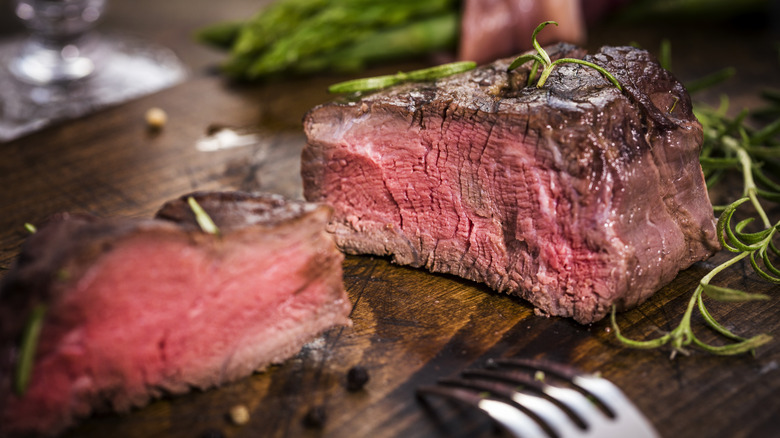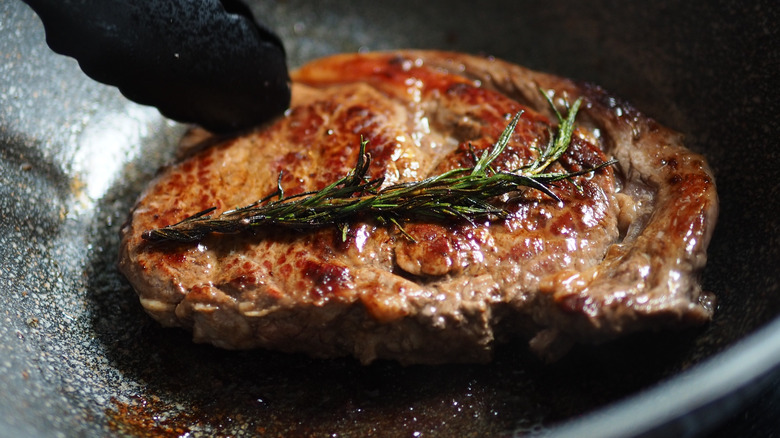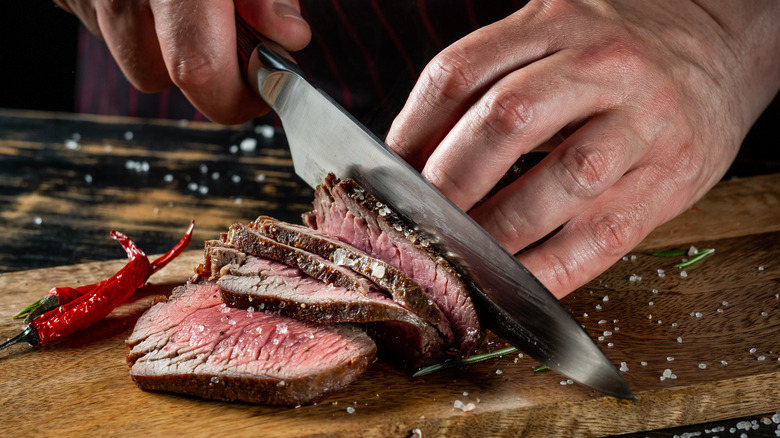What It Means To Cold Sear Steak
For meat eaters, few things are better than a perfectly cooked steak. And like any food, cooking steak comes with tricks and pitfalls for achieving that perfect medium rare. You might, for example, want to reverse-sear the steak, or you can sous vide it or even marinate it after you grill it. But there's another technique of which you should be aware, and it might surprise you: cold searing.
Cold searing involves searing a steak by placing it in the pan before you heat it up. You don't even want to use any oil; you just put the steak right in there. This may seem like an odd choice, but there are more advantages to this method than you might expect. For one thing, it's by far the fastest method to cook steak (since you don't need to let the pan heat up before you get going), and it requires precisely no specialized equipment whatsoever. But perhaps most importantly, it can also lead to a much better overall cook of the steak.
The traditional method to sear a steak in a pan is simple: Take a pan, add some oil, and when it starts smoking, slap your steak on that bad boy. You're flipping the steak once in the middle of the process and probably finishing it in the oven. The goal here is for that hard sear to create a crispy golden brown crust without overcooking the inside of the meat.
Cold searing avoids that undesirable gray ring
But while this may be the traditional method, and the end results look incredible, it's not without drawbacks. In addition to trashing your pans and creating a huge amount of smoke, there's an even bigger problem: You wind up with a thin ring of gray in the meat around the edges as the intense heat leeches into the meat itself.
Cold searing gets around this problem because you're not actually cooking it super hard at any point during the process. Instead, you put the steak in the pan, set it to high, and let it cook for a couple of minutes on each side before turning the pan to medium. You might be wondering, "How do you get a golden brown crust on the steak this way," and the answer is you don't — at least, not immediately.
Unlike the traditional steak cooking method, where you only flip it once, with cold searing, you actually want to flip it multiple times — again, every two minutes. As you do, you'll notice the steak starting to brown up as the crust forms. But because you're repeatedly flipping, there's not enough time for that heat to penetrate the steak itself — only enough to form the crust. The result is the same golden brown crust as with the traditional method but without the gray ring.
Don't salt the steaks right before cooking
There are a few other things to be aware of when it comes to cold searing. You should pat the steaks dry before you sear them because you don't want moisture on the surface. For the same reason, you also want to make a choice that might seem counterintuitive: Don't salt your steak right before you cook it.
This runs in the opposite direction of everything you're taught with meat: You want to season it to get the most flavor possible out of your dinner. And you're still going to salt the cold-seared steak at the end of the process. But the thing about salting is it draws moisture to the surface of whatever has been salted, and that's exactly what you don't want with cold searing. That moisture takes longer for the heat to work through and is ultimately what leads to that gray ring you're trying to avoid. You can, however, salt the steak well ahead of time if you want; you're going to be patting it dry anyway, so giving the salt time to pull the moisture out is fine as long as you let it do its work.
Cold searing may sound counterintuitive, and it does require a slightly more hands-on approach (since you're flipping the steak repeatedly), but the results speak for themselves. Give it a try next time you're searing a steak and you'll see the results firsthand.


